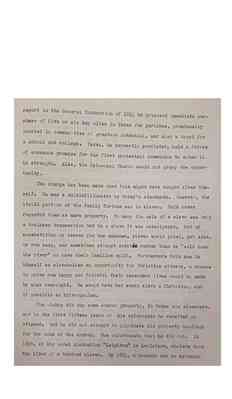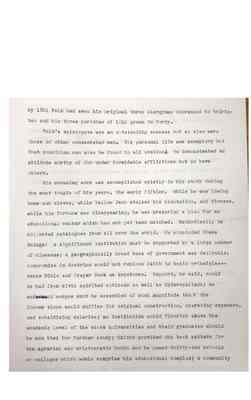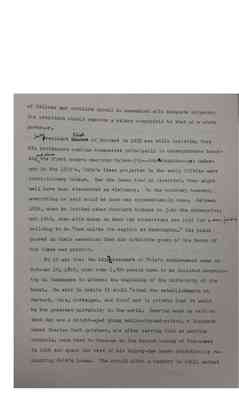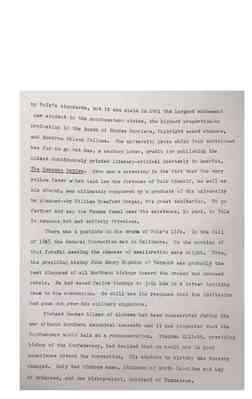Pages
11
report to the General Convention of 1841 he proposed immediate purchase of five or six key sites in Texas for parishes, prominently located in communities of greatest potential, and also a tract for a school and college. Texas, he correctly predicted, held a future of enormous promise for the first protestant communion to enter it in strength. Alas, the Episcopal Church would not grasp the opportunity.
The charge has been made that Polk might have bought sites himself. He was a multimillionaire by today's standards. However, the liquid portion of the family fortune was in slaves. Polk never regarded them as mere property. To many the sale of a slave was only a business transaction but to a slave it was cataclysmic. Out of superstition or terror for the unknown, slaves would plead, get sick, or run away, and sometimes attempt suicide rather than be "sold down the river" or have their families split. Furthermore Polk saw in himself as slaveholder an opportunity for Christian witness, a chance to prove how happy and fruitful their dependent lives could be made by wise oversight. He would have had every slave a Christian, and if possible an Episcopalian.
The bishop did buy some church property, in Texas and elsewhere, and in the first fifteen years of his episcopate he received no stipend. But he did not attempt to liquidate his property holdings for the sake of the church. How unfortunate that he did not. In 1849, at his model plantation "Leighton" in Louisiana, cholera took the lives of a hundred slaves. By 1854, a tornado and an epidemic
12
of yellow fever had cost his and his wife's fortune. They lost enough to have established the Church in all his territories.
With Leighton in the hands of creditors, the Polks moved to New Orleans to enter the last and most rewarding phase of his ministry. In this French Catholic city a bishop had stature not accorded in Baptist communities. He set about culminating his objectives. They were to establish flourishing, self-supporting parishes not only in New Orleans but out among the bayous as well. Polk said "our mission is to all" and he was the counterpart of the modern urban clergyman who can join the Rotary Club without letting it become his religion. He was mission-minded and his parishes sent of their substance to the Society of Missions in New York even after Louisiana seceded. In return there came to Louisiana clergy to establish and serve the isolated churches which could not pay a ministerial salary.
He saw chartered a corporation authorized to receive donations, the interest of which would pay diocesan expenses, help aged clergy, and provide for widows and orphans. He hit upon the plan of asking donors to promise a large capital sum on which they would agree to pay annual interest while retiring the capital amount -- a plan used to good effect in 1859 when he and Bishop Elliott raised for their Southern university more money (in pledges) than had ever been provided before at once for an educational institution in America.
13
By 1861 Polk had seen his original three clergymen increased to thirtytwo and his three parishes of 1841 grown to forty.
Polk's episcopate was an outstanding success but so were those of other consecrated men. His personal life was exemplary but that condition can also be found in all stations. He demonstrated an attitude worthy of Job under formidable afflictions but so have others.
His crowning work was accomplished quietly in his study during the most tragic of his years, the early fifties. While he was losing home and slaves, while Yellow Jack stalked his plantation, and diocese, while his fortune was disappearing, he was preparing a plan for an educational center which had not yet been matched. Methodically he collected catalogues from all over the world. He concluded these things: a significant institution must be supported by a large number of dioceses; a geographically broad base of government was desirable; compromise in doctrine could not replace faith in basic principles--hence Bible and Prayer Book as keystones. Support, he said, could be had from civic spirited citizens as well as Episcopalians; an endowment corpus must be assembled of such magnitude that the income alone would suffice for original construction; operating expenses and subsidizing salaries; and institution could flourish above the academic level of the state universities and their graduates should be admitted for further study; Oxford provided the best pattern for the agrarian and aristocratic South and he named thirty-two schools or colleges which would comprise his educational complex; a community
14
of fellows and scholars should be assembled with adequate stipends; the president should receive a salary comparable to that of a state governor.
Since President Eliot of Harvard in 1875 was still insisting that his professors confine themselves principally to undergraduate teaching and since the first modern American University--Johns Hopkins--got underway in the 1870's, Polk's ideas projected in the early fifties were revolutionary indeed. Had the ideas died in blueprint, they might well have been discounted as visionary. On the contrary however, everything he said could be done was systematically done. Between 1856, when he invited other Southern bishops to join the enterprise, and 1860, when with money on hand the cornerstone was laid for a never-finished building to be "not unlike the capitol at Washington," his plans proved in their execution that this intuitive grasp of the tenor of the times was psychic.
So it was that the high water mark of Polk's achievement came on October 10, 1860, when some 5,000 people came to an isolated mountaintop in Tennessee to witness the beginning of the University of the South. He said in public it would "rival the establishments at Harvard, Yale, Gottengen, and Bonn" and in private that it would be the greatest university in the world. Hearing what he said on that day was a bright-eyed young medico-turned-priest, a Hugenot named Charles Todd Quintard, who after serving Polk as wartime chaplain, came back to Sewanee as the second bishop of Tennessee in 1866 and spent the rest of his thirty-two years relentlessly replanting Polk's ideas. The result after a century is still modest
15
by Polk's standards, but it can claim in 1961 the largest endowment per student in the southeastern states, the highest proportionate production in the South of Rhodes Scholars, Fulbright award winners, and Woodrow Wilson fellows. The university press which Polk envisioned has far to go but has, a century later, credit for publishing the oldest continuously printed literary critical quarterly in America, The Sewanee Review. Even more arresting is the fact that the very yellow fever which laid low the fortunes of Polk himself, as well as his church, was ultimately conquered by a graduate of the university he planned--by WIlliam Crawford Gorgas, the great sanitarian. To go farther and say the Panama Canal owes its existence, in part, to Polk is tenuous but not enitrely frivolous.
There was a postlude in the drama of Polk's life. In the fall of 1865 the General Convention met in Baltimore. On the morning of that fateful meeting the chances of amelioration were slight. True, the presiding bishop John Henry Hopkins of Vermont was probably the best disposed of all Northern bishops toward the broken but unbowed rebels. He had asked fellow bishops to join him in a letter inviting them to the convention. So chill was the response that the invitation had gone out over his solitary signature.
Richard Hooker WIlmer of Alabama had been consecrated during the war without Northern canonical consents and it was suspected that the Southerners would balk at a reconsecration. Stephen Elliot, presiding bishop of the Confederacy, had decided that he could not in good conscience attend the convention. His stature in history was thereby damaged. Only two bishops came, Atkinson of North Carolina and Lay of Arkansas, and one bishop-elect, Quintard of Tennessee.




